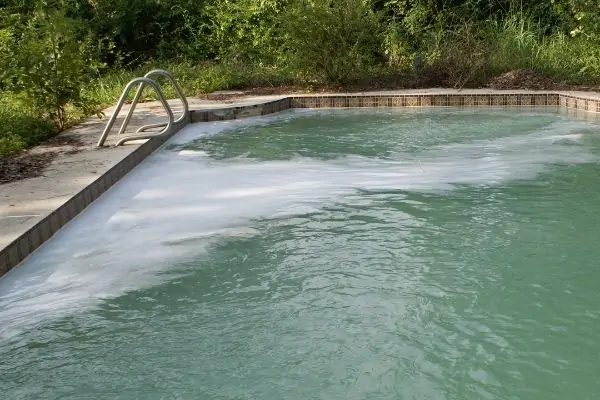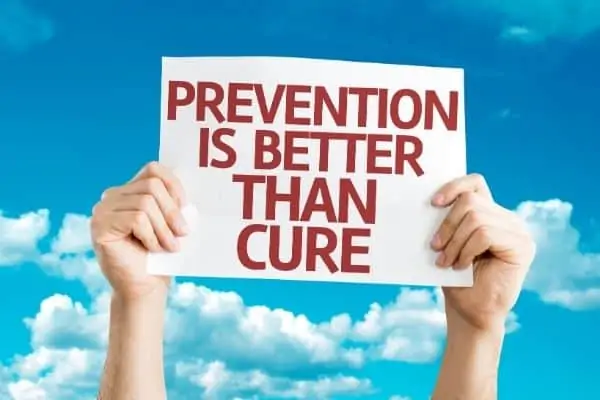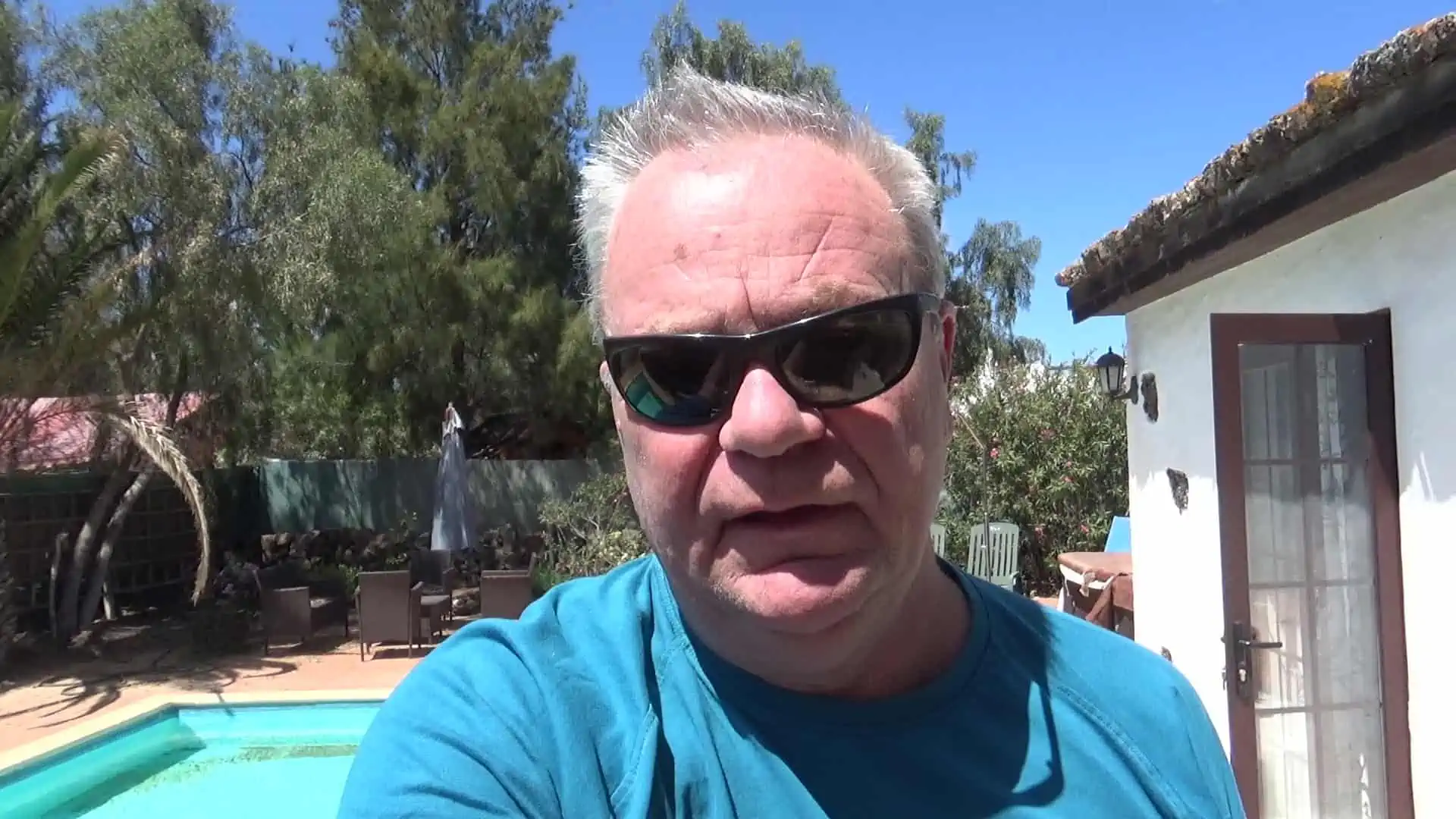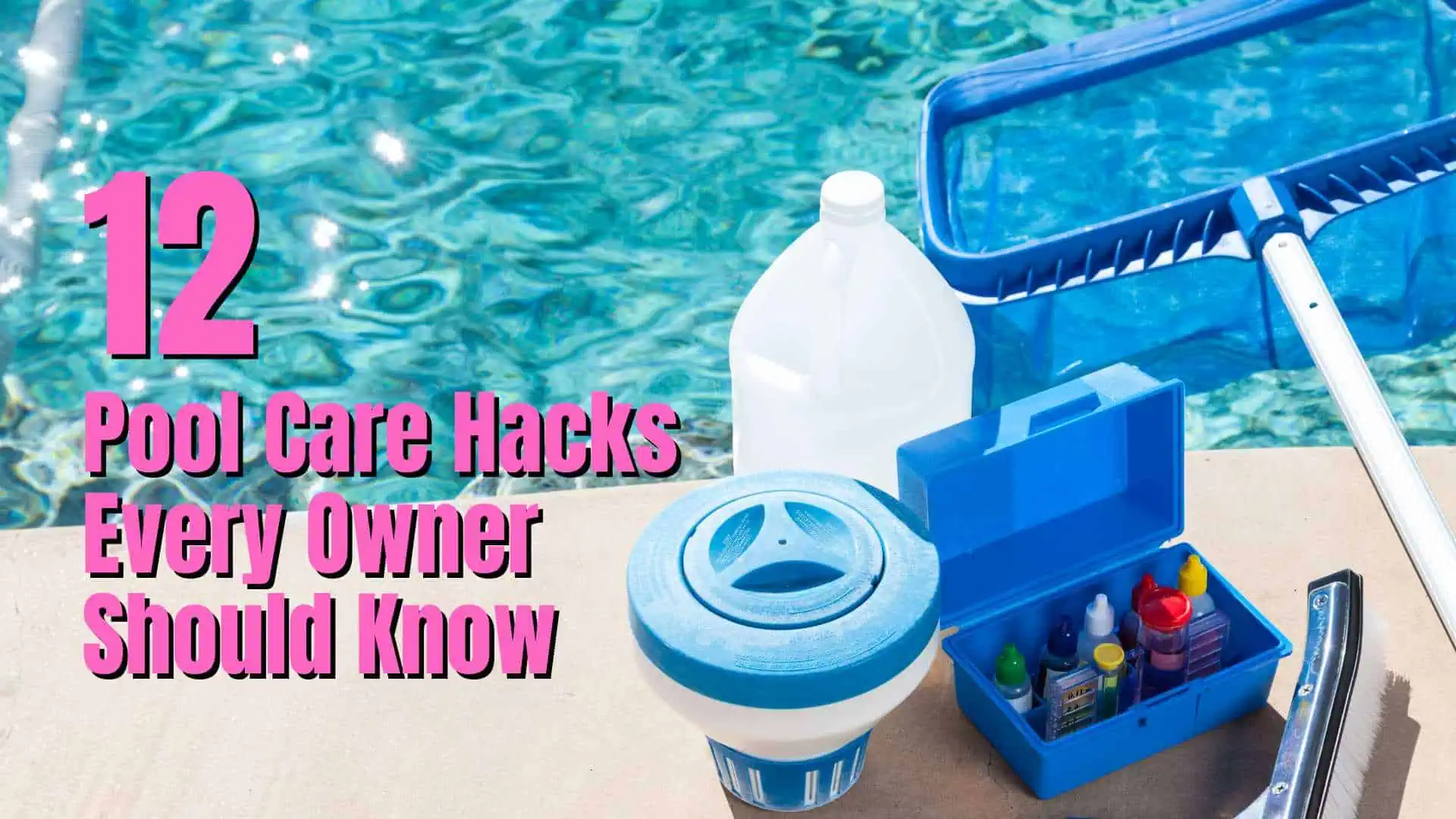It is a common mistake to put too much algaecide in a pool. Sometimes, the amount needed is miscalculated, and at other times, it is added incorrectly.
Too much algaecide results in water in the pool full of tiny foaming bubbles, which can damage the filtration system and cause eye and skin irritation. It is recommended that you stay out of the water until the concentration of algaecide dissipates.
Although adding lots of pool algaecide is a common and understandable reaction to the growth of algae in the pool, it is a mistake.
Algaecide is meant for routine treatment to prevent algae. It is not how to deal with an algae attack. Pool shock is the way to kill algae, and only after chlorine levels reduce to normal should algaecide be added to prevent further outbreaks.
Key Takeaways
Excessive use of algaecide in a pool can lead to harmful consequences. Overdosing on algaecide can disrupt the pool’s chemical balance, causing skin and eye irritation, damage to pool surfaces, and potential harm to aquatic life. It is crucial to follow the recommended dosage on the manufacturer’s packaging.


How to fix too much algaecide in the pool
When it comes to adding algaecide, more is not better. Adding too much algaecide to your pool saturates the water, making it less effective overall, which is the opposite effect the swimming pool owner hopes to achieve.
There are two ways to treat the problem and get rid of too much algaecide in pool water:
- Allow the algaecide to dissipate, which should only take 2-3 days
- Replace some of the pool water and start over
Too much algaecide can cause eye and skin irritation. Until this situation is remedied, sensitive users should not be allowed to swim in the water.
How to neutralize algaecide
The easiest way to remedy the situation of excess algaecide is to continue regular chlorine treatments to maintain the chlorine level and let the algaecide naturally dissipate through the pool filtration system. Be aware that if the situation has caused excessive small bubbles, causing foamy pool water, this may damage the filtration system.
How long does it take for algaecide to dissipate? Allowing the algaecide to dissipate naturally normally takes 2 to 3 days for it to break down, but it could take over a week.
This is not an acceptable option for many pool owners, especially since this situation tends to occur during peak pool-use season. To speed this up, you should regularly use a net to skim off as much foam floating on the pool surface as possible.
Alternatively, the pool owner can choose to drain part of the water and then refill the pool, achieving a greater dilution of the algaecide and starting over with shock treatments and pH balancing. This is a more labor-intensive solution but will open the swimming pool much quicker than waiting for dissipation.
Removing algaecide foam
Once the algaecide levels go down, the foam should disappear after a few days. If you have friends over to swim and need the foam to disappear quickly from the pool surface, you can use an anti-foam chemical such as Pool & Spa Anti Foam Defoamer Concentrate to help reduce the foamy pool water.
Preventing algaecide foam
One of the best ways of ensuring you don’t get algaecide foam is to use a non-copper algaecide such as In The Swim Pool Algaecide 560 Plus, which is non-foaming.
How long does it take for algaecide to work?
When pool owners ask how long algaecide takes to work, it is normally because they have wrongly been trying to use algae to kill an algae attack rather than as a part of their routine pool maintenance to prevent an algae attack.
Algaecide will not work to clear a green pool as you need to use pool shock and only use an algaecide to prevent another outbreak.
How long after adding algaecide can you swim?
Assuming you have followed the instructions on the packaging and have not overdone the amount of algaecide you have put in your pool, you do not need to wait very long.
With the pool pump running to mix the algaecide around the pool, you will normally only need to wait 15 to 20 minutes to swim after adding it, as this will give time for it to dissipate.
Also, read Can I swim 12 hours after shocking pool?
How long does algaecide last in a pool?
Algaecide typically lasts in a pool for 3 to 7 days, depending on the product’s concentration, pool conditions, and algae’s presence.
Regular pool maintenance and monitoring are essential to determine when a reapplication is needed.
Causes of algae bloom
There are multiple causes of swimming pool green algae attacks:
- It has just been opened after the winter
- The chemical levels are not balanced
- Algae have been introduced from elsewhere
One cause of green algae infestation is that the swimming pool has been closed over winter. The algae have been quietly moving in during the off-season. When the weather warms up, the cover is removed, letting in sunlight, which encourages algae to bloom.
It is always recommended to treat the pool with the recommended amount of algaecide before closing it up for the season. This helps keep algae colonies in check during the winter months.
Still, it is assumed that there will be at least some algae in the pool water when it opens in the summer. To prepare for summertime pool fun, the pool is shocked with chlorine and treated with an algaecide.
Summer weather
However, during the summer months, there are multiple causes for algae growth.
One is a lapse in pool testing and upkeep.
The proper dosing of chlorine effectively controls the growth of the most common types of algae. However, when chlorine levels are allowed to dip, whether through neglect or during a vacation, they create a prime environment for algae growth.
As the algae begin to take over the pool, it further disrupts the pH and sanitation chemical balance, making the environment perfect for its own growth so algae thrive.
Another cause of algae infestation is the introduction of algae from elsewhere. If the pool owner has visitors over to swim in the pool, their swim clothing may carry algae from other pools or natural bodies of water, which starts an infestation.
When swimwear and pool toys are used in natural bodies of water, it must be assumed that they now carry algae that will try to infest the pool water. Washing them before using the swimming pool will help in preventing algae.
Prevent algae from moving in

The key to algae prevention is cleaning. The cleaner the pool and the stuff that goes into it is kept, the less likely algae will be present.
- Launder all garments frequently
- Launder all towels frequently
- Clean and disinfect all pool toys
All garments and towels used in a different pool or in a natural body of water must be thoroughly laundered and double rinsed in the warmest water that the fabric can tolerate.
Often, pool owners believe that because they use their own swimwear only in their own pool, they don’t need to launder as often. This is not necessarily the case. As the swimwear is drying, it is exposed to various spores and bacteria in the air. These find warm, wet swimwear to be a perfect breeding ground.
Those bacteria and spores sit and wait for rehydration even when the swimwear is dry. If they aren’t laundered off before the next use, they’re floating around in the warm, sunny pool water, happily reproducing.
Laundry prevents algae
So, the best thing every pool owner can do is to launder all swimwear and towels often. Consider having a swimwear collection for each pool user if this is laborious. They must use a fresh swimsuit and towel each day and then launder all the swimwear and towels simultaneously. Your pool will be much clearer for a longer time.
All pool toys must be sanitized thoroughly with bleach water or another bleach-based cleanser. Pay careful attention to plastic seams and the areas around inflation valves. These areas can easily harbor algae and other bacteria and are difficult to clean.
The same thorough cleaning should happen during the season, even if the pool toys never leave the home. As with swimwear and towels, the plastic seams on pool toys remain moist and warm for a long time as they dry, creating a perfect breeding ground for algae and bacteria.
Pool Care Handbook and Video Course
When I bought my house with a swimming pool, I knew absolutely nothing about pool care. I just winged it for a while, making many mistakes along the way.
Fortunately, I was recommended Swim University’s Pool Care Handbook and Video Course. I bought it and it was an absolute game-changer.
It was the best money I spent that year. I learned everything from basic cleaning to advanced troubleshooting. Swim University offers a no-quibble refund policy too so what do you have to lose?
How to treat algae
The best way to treat algae is not to add algaecide to your pool. Many pool owners wrongly use it to kill algae when they have a green pool, but algaecide should be used as a regular treatment to prevent an algae attack—not to fix it.
Killing an algae bloom involves shocking the pool, perhaps more than once, running the pool pump and plenty of brushing to remove algae from the walls, the floor, steps, etc.
You shouldn’t add algaecide until the pool is clear again and the chlorine levels are normal. If you add algaecide along with the shock, the high chlorine levels will destroy the algaecide effectively.

Add pool shock
You may need to use up to 4 times the amount of chlorine pool shock than you would during your normal sanitization program during pool maintenance when you shock the pool. Mix chlorine in a bucket and empty it all around the pool.
Because sunlight dissipates chlorine quickly, always shock in the evening or overnight to get the full effect of the chlorine disinfectant.
Run the filter/pool pump
After chlorine shocking the pool, run the filter continuously for at least 8 hours or until the water is clear. You should see the dead algae (known as algae dust) lying on the bottom of the pool.
Brush the pool
Brush or scrape down all the pool walls, paying special attention to the ladder, around skimmer boxes and water inlets. Look for cracks and crevices where algae can hide and bloom later.
Vacuum the pool
After brushing, allow anything you have disturbed in the pool water to settle before vacuuming the pool manually.
Ideally, you should vacuum using the waste setting rather than the filter setting of the multiport valve. That way, the dead algae that is vacuumed will be expelled from the pool rather than going through the filter and perhaps passing back into the pool water.
Dead algae are very light, so vacuum slowly to prevent disturbing them too much. Also, Robotic pool vacuums often disturb dead algae as they work, so I won’t use mine to clear up after dealing with algae. They are generally not sufficiently robust to detach algae growths from pool surfaces.
Vacuum all pool areas, paying special attention to shady and discolored areas where the algae are clearly taking hold.
Read my post How to get rid of algae dust from a pool
Finally
Check chlorine levels and add balancing pool chemicals as needed. After the algae attack and subsequent treatments, they will likely be way out of balance.
Now, you can give the pool an algaecide treatment.
How much algaecide to put in the pool depends on the type and make. Follow the instructions on the bottle to ensure you do not add too much. This will help prevent another algae bloom.
Also read: How to get rid of algae in the pool quickly
Conclusion
Pool ownership is a lot of fun but undoubtedly a lot of work. It is best to keep up with the pool chemicals and ensure that the pool water has the correct chlorine levels at all times. This avoids the problem of large algae blooms. However, every pool owner is bound to experience this problem occasionally.
The best solution is to clean the algae thoroughly and start over. This is a lot of work but results in sparkling pool water much sooner. Using too much pool algaecide will further exacerbate the problem and ultimately cause more work for the pool owner.
My top 3 pool cleaning tools
These are the pool cleaning tools I have found the most useful since I have had my pool.
Step and corner vacuum brush
This is a really useful tool for getting into the areas that a standard vacuum head simply cannot reach. Aquatix Pro Pool Step & Corner Vacuum Brush
Leaf rake net
If, like me, you get plenty of leaves at the bottom of your pool then a good leaf rake/net is a must. The Stargoods Pool Skimmer Net gets under the leaves easily.
Robotic pool cleaner
These are quite expensive and it was a number of years before I bit the bullet and bought one. I have never regretted it. The Dolphin Nautilus CC Plus is the most recommended pool cleaning robot on all of the pool forums. It not only cleans the bottom of the pool but also the sides and the waterline.
How long does it take for algaecide to work?
Algaecide should be used to prevent algae growth, not to eliminate an algae infestation. If you add it to a pool to try and kill the algae, it will probably not work. You should use shock to kill the algae and then algaecide to prevent it from reoccurring.
How long after adding algaecide can you swim?
Generally, you can swim 15 to 30 minutes after adding a normal amount of algaecide. However, if you have an algae infestation and have added a large amount of algaecide, you shouldn’t swim until the algae has gone.
Does algaecide lower pH?
Generally, algaecide will not affect the pH of a pool; it will either be raised or lowered.

I have had hot tubs for over 20 years and a pool for the last 10 years. I had to learn how to clean, maintain and fix them the hard way. Since then I have helped many friends and neighbors with their pools and now I want to share everything I have learned with you. About Me





